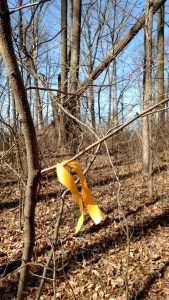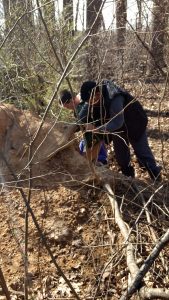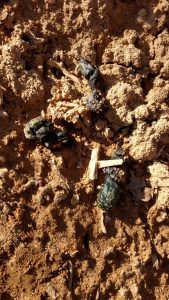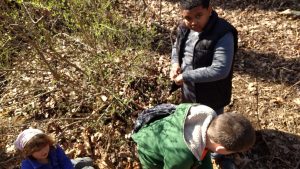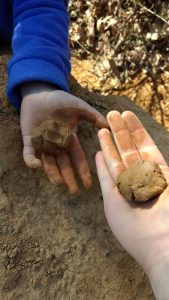Last week we had a blast learning about the maple sugaring process and this week was our first official class on wetlands! Wetlands are critical habitat for a wide variety of plant and animal species and here at Irvine we are incredibly lucky to have a few different types of wetlands. We have year round wetlands dominated by cattails and vernal pools, which are seasonal. We visited the cattails briefly last week and will be revisited them a lot throughout the semester.
We started the day with a rather fascinating topic, Phenology. Phenology is the study of change overtime in plants, animals or climate. We are focusing on Plant Phenology. Each of us picked a plant at the story circle that we are going to observe at the beginning of class each week. We will be recording the temperature, weather and time and date. We will be looking at how our plants change, from when they first have buds (which has already happened!), those buds become leaves, when it first has flowers and so on. Phenology is a relatively simple way to contribute to citizen science and it helps scientists learn about how plants are changing around the country. (I apologize for no pictures of their journals during this activity! I’ll be sure to get some next week :)).
After making our first plant phenology journal entries, Victoria discovered some amazing, natural clay! It was freezing cold from the ground being cold the night before but it was still malleable and sparked with minerals. We played with clay for a while, building structures such as nests and bowls and observing the different components of the clay before starting our hike. Clay actually plays a very important part in wetland hydrology (how water works in wetlands) so we’ll be seeing a lot of clay this semester!
Our hike took us to the back stream that is known as the Frog Hunting stream (no actual hunting happens here, just frog catching!) and the frogs that we are likely to find are still in hibernation so we’ll check back later. We took a snack break here and played around the creek before heading back to the Sugar Shack since it was requested we check out the maple sugar evaporator again.
Before stopping at the Sugar Shack we did a quick activity called Wetland Metaphors. I had a few examples of items, such as a strainer, coffee filter, sponge, hand sanitizer, a pillow case and pictures of rise and a blender. We talked about what a wetland function is and how these items represent some of the functions a wetland performs. We’ll be talking about these a lot this semester so we’ll review them again next week. It was great hearing what everyone guessed! Someone said the blender helped make mud! Here are some of the reasons behind the items: a sponge represents a wetlands ability to hold onto water and prevent flooding in a watershed (we’ll go over this term in class too). The strainer and coffee filter represent how wetlands remove impurities from water as the water flows through them just like how a water filter in your home works. We’re going to make a water filter out of natural items later in the semester. The pillow represents a wetland’s importance as a resting spot for migrating animals or animals seeking shelter. The blender shows how wetlands mix oxygen into the water and create oxygen rich environments for aquatic animals. Hopefully by tying some of these concepts to actual items, like the sponge, it’ll be easier to remember them.
After this activity we only had a few minutes left of class so we checked out the sugar evaporator and also saw that Ms. Hayley’s class was enjoying a story by the fire pit so we joined in before heading back to end the day.
See everyone next week as we learn more about soils!
- Our markers marking our plant phenology study trees and shrubs
- Searching for clay
- We found some scat here too!
- More clay play
- Beautiful natural clay we plan to play with again next class!

